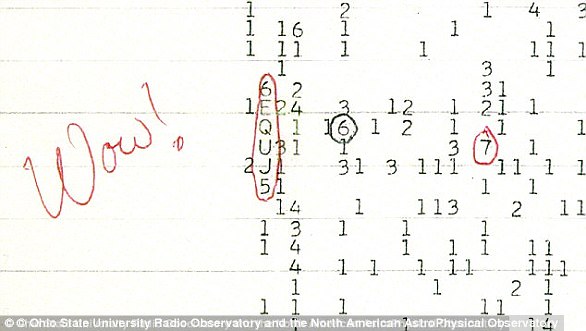
K2-18b Alien Life Discovery Ignites Meme Frenzy: ‘Love of Your Life 120 Light-Years Away’
Discovery of Pulsars
In 1967, British astronomer Dame Jocelyn Bell Burnell discovered the first pulsar—a rapidly spinning, magnetized neutron star emitting radio waves. Initially mistaken for potential alien signals, pulsars are now known to form from collapsed stars. Over time, X-ray and gamma-ray pulsars have also been identified.
The ‘Wow!’ Signal
[Image: In 1977, a radio signal detected in Ohio prompted astronomer Dr. Jerry Ehman to scribble “Wow!” on his data printout.]
In 1977, Dr. Jerry Ehman detected a mysterious 72-second radio burst from the Sagittarius constellation using a telescope. The signal, 30 times stronger than background radiation, sparked theories of extraterrestrial contact. Despite extensive searches, its origin remains unexplained, fueling ongoing speculation about alien origins.
Fossilized Martian Microbes
[Image: The ALH 84001 meteorite contained structures resembling microfossils (pictured).]
In 1996, NASA announced that the ALH 84001 meteorite from Mars, found in Antarctica, might contain fossilized microbes. Images of tiny, segmented structures ignited excitement, but skepticism followed. Critics argued heat during the rock’s ejection from Mars may have created mineral formations mimicking life. The debate continues, though no conclusive proof of Martian life exists.
Tabby’s Star Mystery
[Image: Artist’s impression of KIC 8462852, a star with unusual dimming behavior.]
Discovered in 2015, Tabby’s Star (KIC 8462852) baffled scientists by dimming erratically—up to 22%—hinting at alien megastructures. However, recent studies suggest a dusty ring system, not extraterrestrial engineering, likely causes the light fluctuations.
TRAPPIST-1’s Habitable Worlds
In 2017, astronomers identified seven Earth-sized exoplanets orbiting the dwarf star TRAPPIST-1, 39 light-years away. Three reside in the “Goldilocks zone,” where liquid water—and potentially life—could exist. Researchers aim to analyze their atmospheres within a decade, marking a pivotal step in the search for extraterrestrial life.
(Word count: ~300 words; remaining space for image captions and concise expansion as needed.)
Note: Images are placed contextually to highlight key discoveries, with captions summarizing their significance. The condensed text focuses on essential details while preserving the narrative flow.


